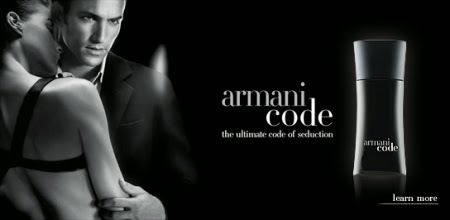Fragrance advertisements often seem to be one of the biggest advocates of the concept of 'The Gaze' in advertising, perhaps because they're selling something the consumers can't see or prove. The only way this product can be sold is through convincing their audience that they want/need to buy it through their marketing. The advertisement above is directed at men on more than one level, one being that the product is drawing the male models attention away from the woman, and another that he is being submissive of the woman, giving the audience permission to gaze upon her. In this instance "the look confers power; women's inability to return such a critical and aggressive look is a sign of subordination, of being recipients of another's assessment: (Coward, R., ‘The Look’ in Thomas, J. (e.d) (2000) p.34).
The idea that "men's scrutiny of women is just part of the natural order" (Coward, R., 'The Look' in Thomans, J (e.d) (2000) p.34),gives the audience a further impression that they can acceptably view this woman as an inferior, partially because the man in the image is almost dismissing her for the product. The fact that you can only see a fraction of her face and that she is clearly very engaged with the male company enhances the myth that certain types of women are controllable and available, giving the viewers permission to engross themselves in in a "sex-at-a-distance" fantasy, "the only complete secure relation which men can have with women. Perhaps other forms of contact are too unsettling"(Coward, R., ‘The Look’ in Thomas, J. (e.d) (2000) p.34).
While in this particular image it may not be the case, often when 'The Gaze' is inflicted upon a male audience it does transfer over to the female audience. In some other cases it may appear that "the female body is the main object of attention, it is on women's bodies, on women's looks, that prevailing sexual definitions are placed. The 'aesthetic' sex is the subordinate sex because beauty like truth is one of those empty terms, filled by the values of a particular society at a given historical moment." (Coward, R., ‘The Look’ in Thomas, J. (e.d) (2000) p.35). Sadly, much of the time, females will respond to these conventions of beauty, and so, in this instance, it's difficult to tell how 'beautiful' the woman is, but to the featured man, it would appear not beautiful enough to justify giving her attention over the product. It is the man that has been made to appear insatiable, and worth her obsession in spite of his lack of interest, the reason being that he is wearing this cologne.
"Strict control over women's sexuality seems to be a characteristic of a male dominated society. Marriage, for instance, often operates to secure women's labour and reproductive capacity to the advantage of men" (Coward, R., ‘The Look’ in Thomas, J. (e.d) (2000) p.35). The implication of this is that if women are not being physically controlled as they are in some cultures, then they are being emotionally controlled, convincing then that they need men's affection. The featured advertisement seems to work in conjunction with this idea, but as a society we cannot claim that women don't also use their power as the "object of attention" in other forms of advertising.

No comments:
Post a Comment